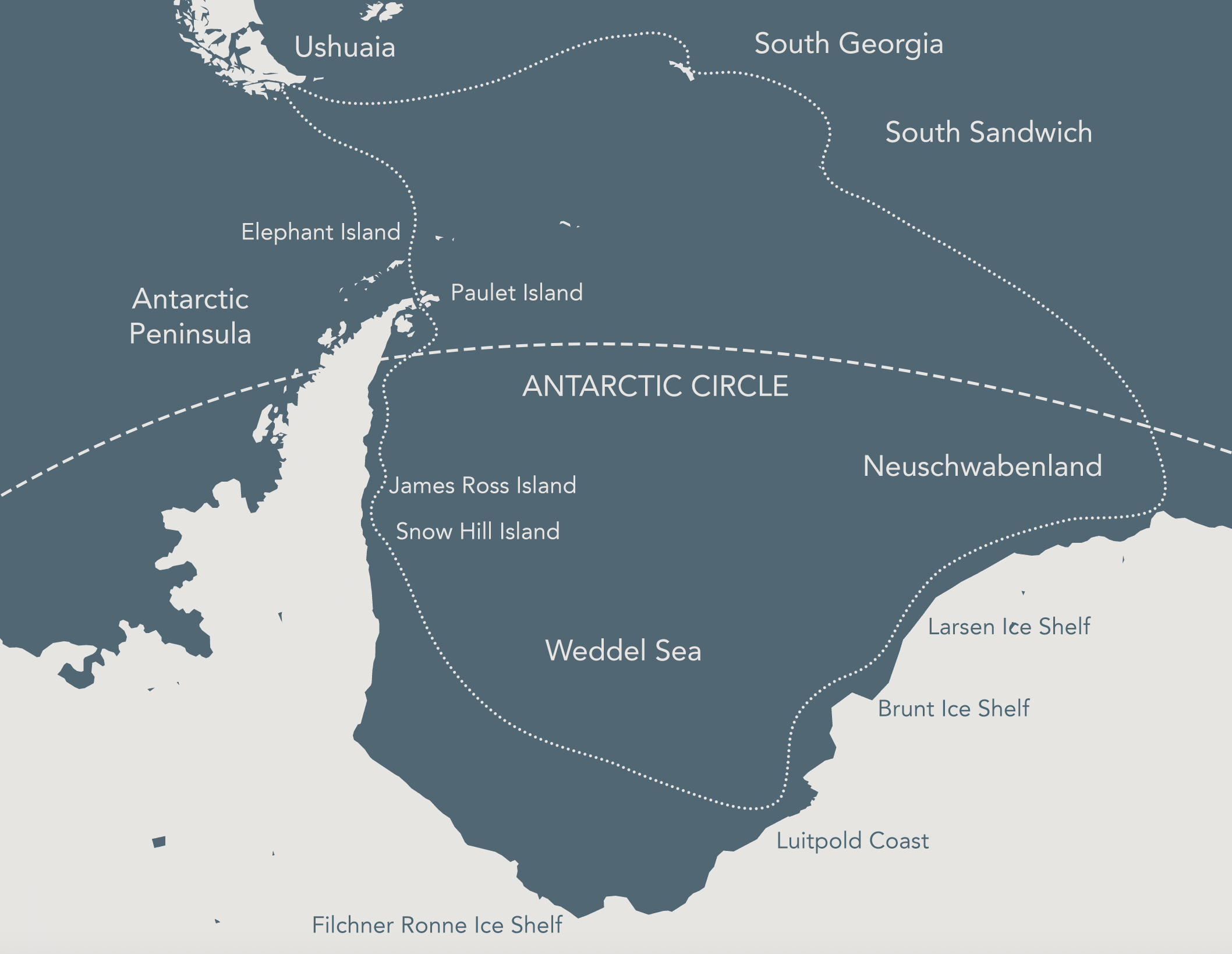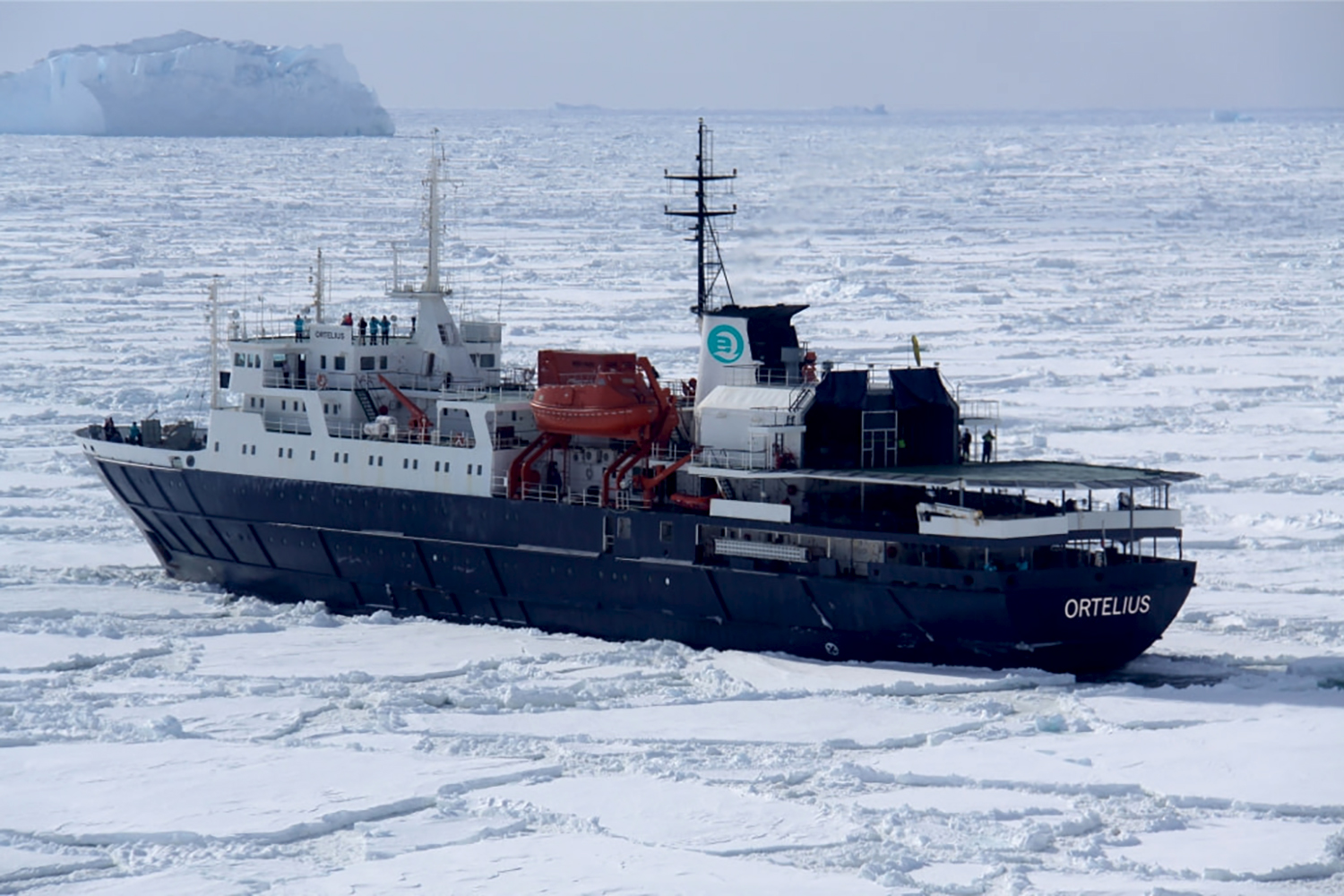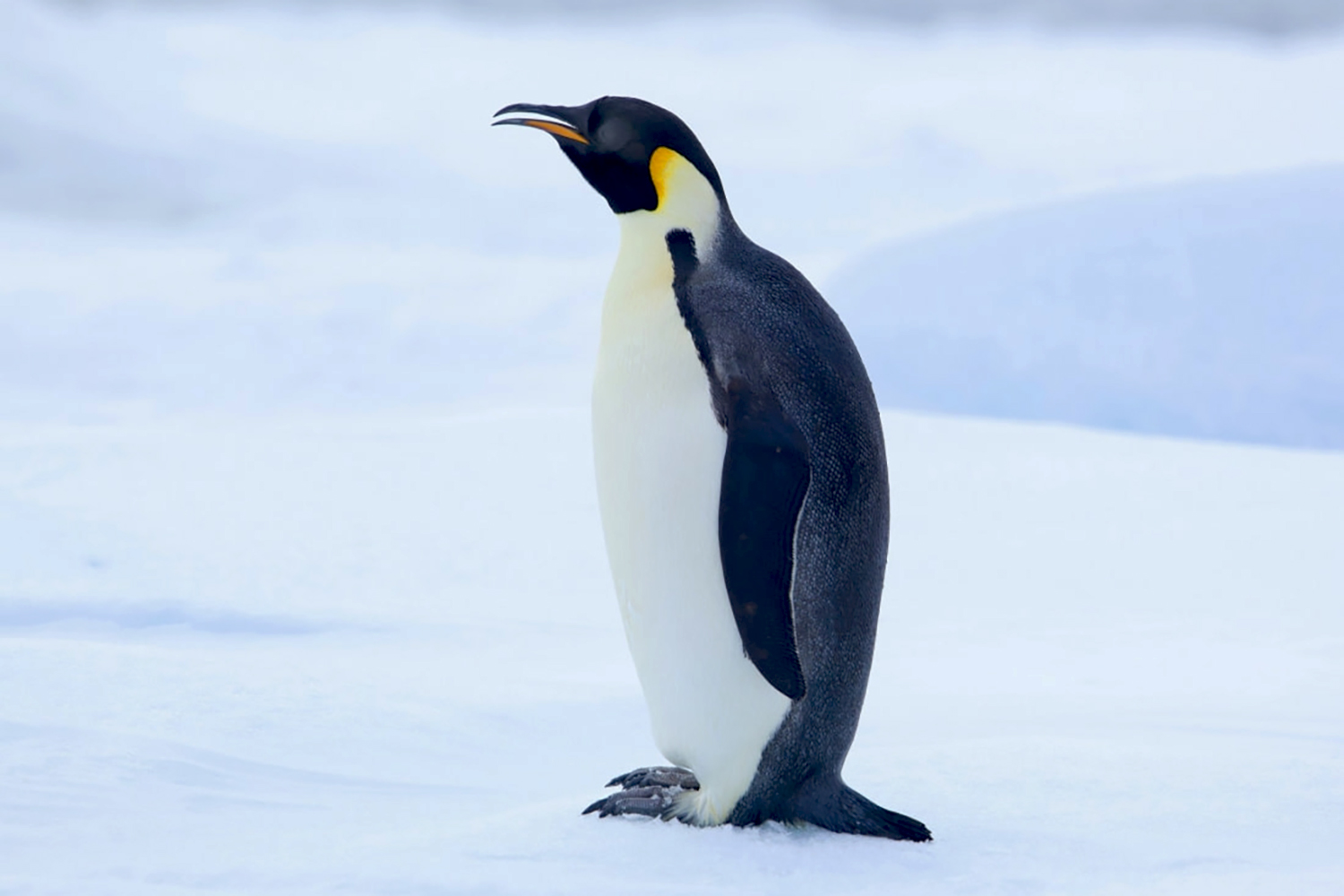Unknown Antarctic
22 January – 18 February 2026
6 BERTHS ONLY
A great polar experience in one of the least explored areas of the Antarctic continent, mostly south of the Antarctic Circle, reserved for just six people.
This epic journey aboard the Ortelius, a former Russian oceanographic research vessel equipped with three helicopters and a capacity of 108 passengers, will explore some of the most remote regions of the Antarctic continent, including South Georgia, the South Sandwich Islands, Neuschwabenland, the Larsen Ice Shelf, Paulet and Devil Islands, Elephant Island, and much of the Weddell Sea. We will sail from the tip of South America to the large penguin colonies of South Georgia, continuing southeast to the remote and ghostly South Sandwich Islands, and then along the continent's coast near Neuschwabenland and the Weddell Sea, where the glaciers and snow-capped peaks of the sixth continent reign supreme. The grandiose panoramas and enormous icebergs will provide the backdrop for an incredible fauna: orcas, fin whales, humpback whales, elephant seals together with hundreds of thousands of king penguins, macaroni penguins, gentoo penguins, Antarctic penguins, Adelie penguins and with a bit of luck even emperor penguins, as well as 5 species of seals including the fearsome leopard seal.
Program
22 January
Arrival in Ushuaia and boarding the MV Ortelius, a former Russian oceanographic research vessel built for polar waters. It can accommodate up to 108 passengers, making it ideal for a journey like this, which requires several days of open sea navigation. The ship is equipped with three helicopters and 10 zodiacs, allowing us to explore the region from completely new perspectives. Only 3 cabins are availabkle for our group.
* HELICOPTER EXCURSIONS ARE INCLUDED IN THE PRICE AND WILL BE OFFERED WEATHER PERMITTING. A SPECIFIC NUMBER OF FLIGHTS CANNOT BE GUARANTEED IN ADVANCE.
We will immediately begin our cruise through the Beagle Channel and then head east into the Atlantic Ocean.
Overnight on board.
23-24 January
As we sail east across the Atlantic Ocean toward South Georgia, Albatrosses and Giant petrels will follow our vessel, offering excellent viewing opportunities.
Overnight on board.
25-27 January
Today we’ll arrive along the northeastern coast of South Georgia, where we’ll spend the next three days.
Shore excursions will be weather-dependent and may include:
Salisbury Plain, a spectacular plain bordered by the Lucas and Grace Glaciers, home to the island’s second-largest colony of King Penguins. Sixty thousand pairs, which grow to 250,000 during moulting season, are everywhere, literally as far as the eye can see. Salisbury Plain isn’t just about penguins; there are also Fur seals and Elephant seals, the latter gathered in one of the largest colonies in South Georgia.
Prion Island, a small island that is a veritable sanctuary for the Wandering Albatross, the living bird with the largest wingspan, which comes here every year to breed.
Fortuna Bay offers picturesque alpine scenery and is where Shackleton arrived after crossing the island from west to east and before reaching Stromness. A colony of King Penguins occupies the space in front of the König Glacier, about a kilometer from the beach, where Elephant seals and Fur seals are present. A small colony of Gentoo Penguins also lives in the bay, and Light-Mantled Albatrosses are often spotted, as well as Reindeer introduced here by Norwegian whalers.
Stromness, where the remains of the whaling station abandoned in the 1960s offer a glimpse into the life of whalers in the last century. Reindeer, fur seals, Antarctic terns, Skuas, Elephant seals, and a small colony of Gentoo Penguins inhabit the bay.
Saint Andrews Bay, where several peaks over 2,000 meters high form the backdrop to the enormous and endless colony of King Penguins, the largest on the island, numbering approximately 150,000 pairs. The beach is also home to the largest concentration of Elephant seals in South Georgia, as well as numerous Reindeers. Such a large concentration of animals cannot help but attract predators and scavengers such as Petrels, Skuas, Terns, and Albatrosses, as well as the voracious Leopard seals.
Grytviken is the island’s administrative center and offers visitors several attractions: the church, the old whaling station, the museum, Shackleton’s grave, the post office, and the scientific station. Elephant seals and Fur seals are quite common, as are King penguins.
Gold Harbour, a natural amphitheater of hanging glaciers and vertical rock faces dominated by the snow-capped peak of Mount Paterson. 25,000 pairs of King penguins, 300 pairs of Gentoo penguins, Giant petrels and Terns, King cormorants and Albatrosses, Fur seals, and Elephant seals inhabit the bay.
Cooper Bay, the fauna here is unlike anything we’ve encountered before. We’ll find four penguin species: the island’s largest colony of Antarctic penguins, with approximately 10,000 pairs; several thousand Macaroni penguins; 4,000 pairs of Gentoo penguins; and approximately 250 pairs of King penguins.
Overnight on board.
28-29 January
Sailing south across the Atlantic Ocean toward the South Sandwich Islands. This sea in this region is often heavily ice-covered and will test our vessel’s navigational capabilities.
Overnight on board.
30 January
Today we’ll reach the South Sandwich Islands, one of the most remote and unknown archipelagos on the planet. Although it’s not possible to disembark on the islands, we’ll be able to take excursions using zodiacs to explore the coastline and admire the beautiful and wild landscapes of this active volcanic area.
Navigating the narrow passage between the Thule and Cook Islands, in particular, will be one of the many highlights of the trip and will leave an unforgettable memory.
There’s a good chance of encountering Humpback and Minke whales in this area, as well as Brown skuas, Antarctic and Adélie penguins, and several species of albatross.
Overnight on board.
31 January-02 February
We’ll continue sailing across the Antarctic Circle towards the continent, Queen Maud Land, and Neuschwabenland, located on the northeastern edge of the Weddell Sea.
Overnight on board.
03-04 February
Our first destination on the Antarctic continent is the legendary New Swabia, between 20° E and 10° W in Queen Maud Land. This area, rarely visited by ships, was explored by Germany during the Third German Antarctic Expedition of 1938-1939, led by Alfred Ritscher. The aim was to find a site for a German whaling station and to scout a possible location for a naval base.
In an attempt to reclaim the region, Nazi flags were raised on the sea ice along the coastal areas. Reconnaissance flights also dropped metal swastikas.
Legend has it that this expedition was organized by the army for purely military purposes. According to some sources, the legendary Base 211 is hidden beneath the ice, where the Germans attempted to build new weapons. Other theories point to this place as Hitler’s secret hideout, from where he would have established the foundations for a future Fourth Reich, before setting out to conquer the world.
Overnight on board.
05-13 February
The next few days will be dedicated to the exploration of the Weddell Sea, where Crabeater, Leopard, and Weddell seals are likely to be spotted. With a bit of luck, we might even spot Emperor penguins; in this region, in winter, there are numerous colonies of these splendid animals, and in the summer, they rest on the drifting ice. Another common presence are cetaceans: Humpback whales, Killer whales, and Minke whales, as well as a wide range of birds.
Ice conditions in the Weddell Sea vary seasonally, and we’re sure to encounter a large amount of drifting ice and formidable sea ice when we reach the higher latitudes, the far south, where we can enjoy the wild beauty and grandeur that make Antarctica so special. Here, we’ll understand why it took so long to discover the Great White Continent and how difficult it was for explorers.
We will follow a circular route toward the Brunt Ice Shelf and along the Luitpold Coast, discovered and named during Wilhelm Filchner’s second German Antarctic expedition. If conditions permit, we will have the opportunity to land on an ice floe. We will then head west toward the Filchner-Ronne Ice Shelf before changing course north, following the coast along the eastern side of the Antarctic Peninsula and the Larsen Ice Shelf. This brings us close to the spot where Shackleton’s ship, the Endurance, became trapped in the ice during his Imperial Transantarctic Expedition (1914–17), drifting toward the Antarctic Peninsula before finally sinking.
In a thrilling conclusion to this story, the wreck was discovered on March 5, 2022, the centenary of Shackleton’s burial, after 107 years beneath the waves of the Weddell Sea. Although we won’t be able to get close to the discovery site due to the pack ice, we’ll be in the area where the ship was trapped and abandoned. There are colonies of 6,500 emperor penguins nearby, so we’ll have a good chance of spotting them.
Reaching the northern part of the Antarctic Peninsula, we’ll enter the Gulf of Erebus and Gulf of Terror. Emperor penguins, which migrate through the area, often rest on the numerous ice floes of Snow Hill Island. If conditions permit, we may attempt a landing on James Ross Island.
Overnight on board.
14 February
This morning, we hope to disembark in one of the most scenic spots on the northern Antarctic continent, home to a large colony of Adélie and Gentoo penguins. The sheer canyon walls, crumbling boulders, and stunning ice-covered volcanic formations make Brown Bluff a truly unforgettable place.
Across Antarctic Sound lies Kinnes Cove, where you can admire the nearby Madder Cliffs with their delicate red coloring, as well as more Gentoo penguins.
Overnight on board.
15 February
Elephant Island is the point from which Shackleton set out to seek help for his crew, now stranded here after their ship, the Endurance, sank in the Weddell Sea. Using only a small lifeboat, the James Caird, he and five of his men set sail for South Georgia. It took them four and a half months to complete the legendary rescue.
The island’s conditions are harsh; the coast consists primarily of vertical cliffs of rock and ice, highly exposed to the elements. If conditions permit, we will disembark at Point Wild, where members of Shackleton’s expedition miraculously survived.
Overnight on board.
16-17 February
As we sail north in the Atlantic Ocean towards Ushuaia, the Albatrosses and the Giant Petrels will follow our vessel, offering excellent observation opportunities.
Overnight on board.
18 February
After breakfast, we’ll disembark and reach the airport in time for our return flight.
*This is a true expedition into little-explored areas, so the program may vary depending on weather conditions or animal sightings; flexibility is essential.
Contact us
Included in the price:
- Voyage aboard Ortelius as indicated in the itinerary.
- Free use of rubber boots.
- All excursion and activities throught the voyage.
- Three meals a day during the cruise.
- Group transfer from ship to airport.
Not Included:
- Flight.
Price:
PRICE PER PERSON Twin Porthole Cabin Euro 25.000
*SPECIAL 5.000 EURO DISCOUNT ALREADY DEDUCTED FROM THE PUBLIC PRICE (EURO 30,000)
EXCLUSIVE AND RESERVED FOR ASSOCIAZIONE VIAGGIPOLARI
(different cabin categories available, ask for details)







